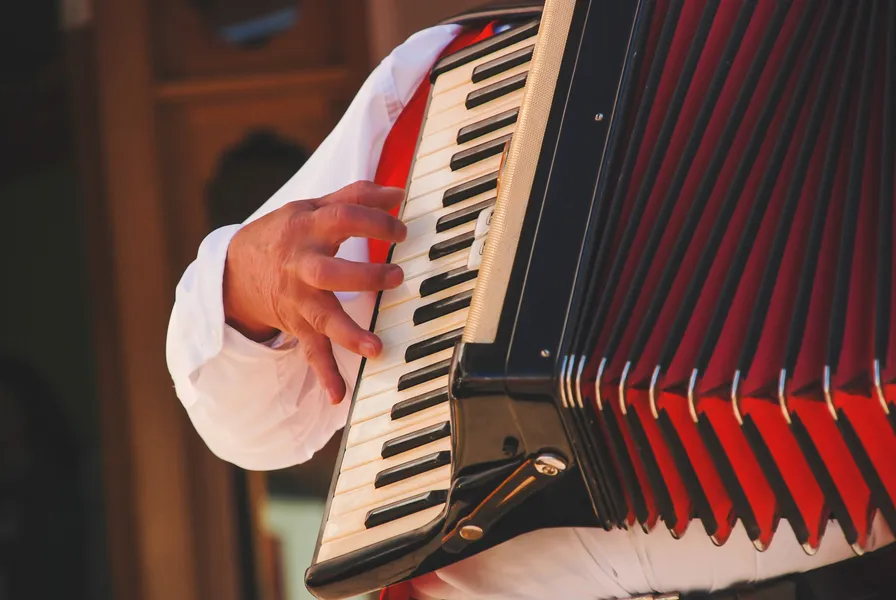

Piano Accordion: History, Features, and Variations
The piano accordion stands out as a versatile instrument that combines a piano-style keyboard with the mechanics of an aerophone.
The piano accordion stands out as a versatile instrument that combines a piano-style keyboard with the mechanics of an aerophone. In this article, we will explain its history, key features, and various forms, helping you better understand how this instrument became a musical staple in many regions.
The piano accordion, invented in the mid-19th century, features a piano-style keyboard for melody and buttons for bass/chords. It gained popularity for its versatility and became integral to many genres, including Celtic music, where it serves as both a melodic and accompaniment instrument.
Learn more about how the piano accordion originated, its features, and how it has adapted to different musical styles. Whether you're curious about its mechanics or its role in various genres, we have plenty of great insights to share. Keep reading for more!
Overview

The piano accordion is a type of accordion that features a right-hand keyboard similar to a piano or organ. It functions by pushing air over reeds, categorizing it as an aerophone, differing from the piano's string-hammer mechanism. This setup allows the right hand to play melody notes on the piano-style keys, while the left hand manages bass notes and chords through buttons. The keys on the piano accordion are typically smaller and lighter than those on a traditional piano, positioned vertically for one-handed play.
The name "piano accordion" was first introduced in 1910 by Guido Deiro, whose efforts greatly boosted the instrument's early 20th-century popularity. Designed to be familiar to those accustomed to piano playing, the piano accordion provided musicians with a versatile tool suitable for a variety of musical genres. Although named after the piano, its sound production is more like that of an organ. The instrument has gained widespread recognition due to its practical design, allowing simultaneous melodic and harmonic play, making it adaptable for both traditional and contemporary music.
Design and Mechanism

The piano accordion differs from instruments such as the piano and organ in its design and sound production. While it offers a keyboard layout on the right-hand side resembling the piano, the mechanism of sound creation is entirely different. The piano relies on hammers striking strings to generate tone, whereas the piano accordion uses air pressure directed over reeds to produce sound. The keys on the accordion are lighter, smaller, and rounded, designed for easier handling during one-handed play. Unlike the horizontally arranged keys of a piano, the accordion’s keyboard is vertical, positioned parallel to the bellows.
The left-hand system of the accordion also diverges significantly from these instruments. Rather than chords created by manual finger placement on keys, the left-hand buttons are grouped into systems that simplify access to preselected bass notes and chords. These systems include the Stradella bass, which organizes buttons by rows and columns, or the free-bass system, offering more flexibility for individual note selection. Together, the right-hand keyboard and left-hand button systems allow the accordion to deliver melody and accompaniment simultaneously without the need to rely on multiple players or instruments, offering a compact yet versatile tool for musical performance.
Variations
The bass piano accordion is a variation of the standard piano accordion, designed specifically to emphasize lower-pitched sounds. Unlike a typical piano accordion, which is built for both melody and accompaniment, the bass version focuses on providing deeper bass tones to complement other instruments or ensembles. This variation is particularly useful in situations where a stronger bass presence is needed, such as certain orchestral or band settings.
One key difference lies in the setup and function of its left-hand buttons. The bass piano accordion may be equipped with free-bass systems, which allow for a wider range of individual bass notes rather than pre-set chord buttons. This design gives players the ability to perform more complex bass lines or harmonies. The sound of a bass piano accordion is often fuller and concentrated on the lower registers, lending support to the overall arrangement.
In terms of usage, the bass piano accordion is not typically used as a solo instrument but rather as part of a group. Its role is comparable to that of a bass guitar or double bass, forming the foundation of a piece by providing rhythm and depth. This variation is a specialized tool for musicians who require detailed control over the instrument’s lower range.
Historical Development
The piano accordion’s origins are surrounded by multiple claims, with inventors across various countries advocating for their role in its inception. While it is difficult to pinpoint the exact inventor, early prototypes emerged in Europe during the early 19th century. These designs combined keyboard functionality with bellows-driven air movement, laying the groundwork for modern models. By the mid-19th century, significant improvements were made, including the addition of left-hand button systems to produce bass and chords.
In Russia, the accordion gained rapid popularity due to its portability and suitability for folk music traditions. Russian manufacturers refined the design by creating variations tailored to regional musical styles. This growth expanded its appeal across communities. Meanwhile, in the United States, the piano accordion’s usage surged in the early 20th century, propelled by its adoption in Vaudeville performances. Entertainers showcased the instrument’s versatility in both comedic acts and musical routines, solidifying its place in popular culture.
The piano accordion also rose to prominence in specific geographic regions, driven by its adaptability to various musical genres. From European classical arrangements to American folk music, the instrument embedded itself in diverse traditions. Across continents, its ability to function as both melody and accompaniment contributed to lasting appeal among amateur and professional musicians alike.
Structural Features

The piano accordion is characterized by its dual-section structure, with the right-hand keyboard and left-hand button system serving distinct but complementary functions. The right-hand side features a piano-style keyboard. This allows players to produce melodies and play harmonies using a system familiar to those with a background in piano. The number of keys on this keyboard can vary, but it typically ranges from two to three octaves, depending on the size and type of the instrument.
The left-hand side is comprised of bass and chord buttons. These buttons are arranged in a systematic layout to provide accompaniment, with the bass notes positioned closer to the player and the chord buttons farther away. Standard configurations include major, minor, seventh, and diminished chords, giving players the ability to harmonize quickly. The arrangement is designed to follow the circle of fifths, simplifying transitions between chords.
Different models of piano accordions offer varying numbers of chord buttons and levels of complexity. Smaller instruments may have a limited number of buttons, suitable for beginners or simpler musical pieces. Advanced models provide extended options, often including multiple rows of buttons or free-bass systems for greater versatility. These structural features enable the piano accordion to function flexibly across a range of musical styles and skill levels.
Versatility of the Piano Accordion

The piano accordion is widely recognized for its adaptability across different musical genres and playing styles. Its widespread acceptance can be attributed to its dual keyboard design and systems that cater to varied technical demands. One of the commonly used configurations in piano accordions is the Stradella bass system. This layout organizes bass and chord buttons by the circle of fifths, with major, minor, seventh, and diminished chords arranged systematically. This design enables quick chord transitions and is particularly useful for accompaniment.
In addition to the Stradella system, some advanced accordions feature free bass systems. Unlike the fixed chord structure of the Stradella layout, free bass systems offer single-note basses, giving players an expanded range of notes and greater melodic freedom on the left-hand side. This system is commonly used in classical music or complex arrangements requiring counterpoint.
Converter bass systems incorporate the strengths of both the Stradella and free bass systems. With a switch, players can alternate between the standard chord-based setup and the single-note flexibility of the free bass configuration. This versatility appeals to musicians who want to shift between different styles or explore more sophisticated techniques. Together, these systems contribute to the piano accordion’s role as a multifaceted and adaptable instrument.
Role in Celtic Music
Celtic music, originating from the folk traditions of regions like Ireland and Scotland, is known for its melodies and rhythms often connected to dance. The piano accordion has become a central instrument in this style, contributing to both melodic and accompaniment roles.
On the melodic side, the piano accordion is effective in performing the fast-paced pieces common in Celtic music, such as reels, jigs, and hornpipes. The keyboard allows players to execute these melodies with clarity and consistency, while the bellows help shape the phrasing, adding expression suited to the traditional style.
For accompaniment, the accordion works through its left-hand configuration, where bass and chord buttons provide support for the primary melody. By laying down a rhythmic and harmonic foundation, the accordion complements other instruments within an ensemble, such as fiddles, flutes, and percussion, helping to maintain the structure and unity of the performance.
In Celtic music ensembles, the piano accordion not only bridges melodic and harmonic aspects but also plays a functional role in maintaining balance between different instruments. Its ability to contribute both energy and structure has ensured its continued use in traditional settings as well as in evolving, modern approaches to the genre.
Final Thoughts

The piano accordion combines the familiar design of a keyboard with reed-based sound production, allowing it to perform both melodic and harmonic functions within a single instrument. Its versatility has cemented its place in many musical styles, including classical, jazz, folk, and Celtic traditions.
Whether played alone or in group settings, it has proven to be an adaptable tool capable of meeting various musical demands. Since its development in the 19th century, the piano accordion has remained relevant, offering opportunities for both musicians and listeners to engage with its broad range of expressive capabilities. For performers or enthusiasts, learning about this instrument provides insight into its sustained role across different styles of music.

What is Celtic Music?

